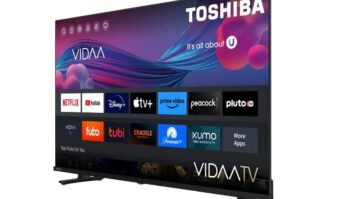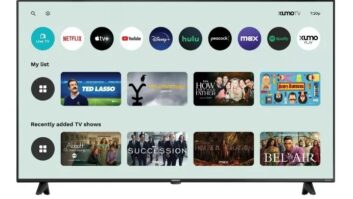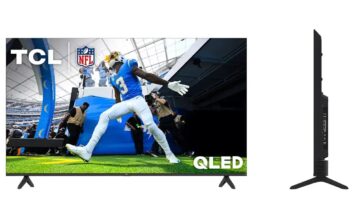TWICE:
Is TV being displaced by tablets and smartphones
as the cornerstone of CE retail?
Jim Ristow, executive VP, Home Entertainment
Source (HES):
We’re at the same early-adopter stage
of the connected world that we were at in ’99 with
high-definition TV. This is the wave we need to ride.
That said, TV is still an important category and a
huge dollar industry. Even though ASPs [average selling
prices] are declining, you are really looking at a
shopping cart approach. The A/V receiver business
greatly outpaced projections, and the speaker industry
also outpaced the industry. We have to take those
other parts and really build on it. There are things there
to help bring more profit potential to all of our businesses,
and you can’t just look at the TV part.
Dave Workman, executive director/COO, PRO
Group:
Amazon has taught the customers “everything,
everywhere, all the time” when it comes to content.
The library effect that the Internet has brought
to the consumer is tremendous in its potential, and it
plays well into the television future.
What is happening right now is the trend to multiple
screens. What has changed and what will continue to
change is the fact that in the future the one set in the
living room is just one of many devices. People are
interacting with their content with a multitude of devices.
The tablet and the phone will play a part. The
generation behind us will ask why someone would just
sit in one place and watch a movie when it could be
seen anywhere at any time. Retailers have to be cognizant
and recognize this trend because it has become a
multiple-screen experience.
Karen Austin, president, home electronics,
Sears Holdings:
We need to educate people
about the value of the connected world. A compelling
reason to purchase IPTVs or smart TVs is their ability to instantly download web applications and
the ability to purchase movies or music, and the
connected TV will be moving from the early adopter to the early majority much faster than
3DTV, although most models will
eventually have both features.
Buyers were attracted to the slim size
and then the quality of the picture, but
having the immediacy of being able to
watch a movie instantly will be the biggest
driver. Buyers understand that feature
more now just because of all the
other categories that are driving it.
Bernard Luthi, Newegg.com:
IPTV,
smart TV, is far and away the more prevalent
buy with the
audience.
They buy it because it’s new and it’s a
technology that they like, and they are using
it from the smart TV standpoint.
Dan Schwab, D&H Distributing:
People I know who have 3DTVs are using
the product more for IPTV purposes.
After the first month of showing their
friends a movie with the goggles and putting
them on for 2D content, their children
use it for Facebook and YouTube. It’s the
content that they want to get. They’re using
IPTV as a big web browser, to some
degree. In terms of functionality, that’s
where people have gravitated.
Austin:
Smartphones and tablets are
more interactive, and buyers want that
with the TV.
Michael Vitelli,
Best Buy:
The consumer
expectation from the smartphone, the tablet and the computer is that they
will be able to customize them to their individual
wants. But then they get the TV
and they can’t.
Currently, the TVs are blocked by the
individual manufacturer’s applications.
At the end of the day, that will not work.
The consumer says here are my applications.
I have six. They are on my phone,
my tablet, my computer and my TV.
Whatever I own or whatever is free, that’s
what I watch it on — that is my user experience.
I have created it. I don’t want
5,000 apps, I want my particular six, and
they are on my four screens.
The TV industry needs to figure out
how to get there outside of adding a different
box. Because the TV industry has
not figured that out, everybody else has
been coming in saying if you attach this
to your TV you could do it. The TV manufacturers
have to be on some common
platform, and it can’t be that I have to rebuy
the app and have a different service
on every TV because of different platforms.
That will not fly with consumers.
What consumers are doing seems to
be clear. How fast the industry is going
to respond to it to allow it to happen
seems to be the question. If it doesn’t,
the TV business will continue to stagnate.
The 30 million units are going to go
out, and the ASPs are going down. We
were riding a very strong curve of ASP growth with unit growth during the HDTV
transition. Now it has leveled off.
The question is what is the next curve?
Will 3D get me to go out and buy a new
TV? Clearly not yet. Would it be a TV
that allows me to have the same applications
that I like to use on all of my four
screens? I think so.
Ross Rubin, The NPD Group:
It’s
very difficult to develop a platform.
Workman:
One of the challenges that
manufacturers face is their fear that their
sets are relegated to being dumb terminals,
and they really are resisting change.
Today you have these other screens that
a whole generation of users is associating
with their televisions, “my” TV. We are
seeing a transition in which television use
was a communal experience and it is now
an individual experience. You are seeing
the very beginnings of a seismic change
in the viewing habits of the next generation.
It’s my content on my device when I
want to watch it. Television vendors want
to hold their own little proprietary content
out of fear.
Rubin:
I don’t think any of the vendors
could make a compelling case for the
value of apps on a television other than
content services like Pandora or You-
Tube, which perhaps would make sense.
It has no relevance on TV.
Workman:
There is a lot of cool stuff
like picture-on-picture — you can affix
multiple images and whatever kinds of
apps to larger screens. But we have to
bring it to life and get it all out in front
of the customer. That is the next level of
growth for television sets. If you change
the user experience, that is when you
compel the customer to come back and
chuck the old device. They are looking
for an experience that they can’t have unless
they get this particular set.
Vitelli:
If the big fourth screen is
opened up for application development,
we’ll be thrilled with what the world develops
for it. If we wait for five manufacturers
to develop what they think is good
for it, we won’t.













